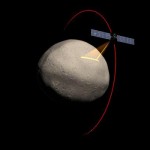
Research conducted by Jet Propulsion Laboratory (NASA JPL) and California Institute of Technology, demonstrates the use of SysML in modelling the Ground Data System (GDS) for the Dawn spacecraft. The case study briefly discusses the advantages of a SysML model over an MS Excel® spreadsheet and also mentions how a similar GDS model could be used for other missions as well by just making a few changes to the original model, which would enable reusability and reduce design time.
System models are often touted as engineering tools that promote better understanding of systems, but these models are typically created during system design. The Ground Data System (GDS) team for the Dawn spacecraft took on a case study to see if benefits could be achieved by starting a model of a system already in operations. This paper focuses on the four steps the team undertook in modeling the Dawn GDS: defining a model structure, populating model elements, verifying that the model represented reality, and using the model to answer system-level questions and simplify day-to-day tasks. Throughout this paper the team outlines their thought processes and the system insights the model provided.
These advantages of modeling over traditional approaches were identified:
- The ability to have different views. When describing any system as complex as a spacecraft it is necessary to create multiple views for different audiences and purposes.
- The use of a standardized modeling language like UML or SysML imposes a standard convention so that no matter which diagram the reader is looking at, the meaning of each symbol is unambiguous.
- Maintaining consistency across all the views. The advantage of a modeling tool over these presentation or drawing tools is the model itself. If element names or relationships change over time, those changes are automatically propagated to all system views.
- The modeling tool understands basic information about the system being described and can be the first line of defense against inconsistency. For example the modeling tool can perform type-checks between interfaces, so if a modeler attempts to draw a connection between two incompatible ports, like 1553 and Ethernet, the tool will flag it.
- A model enforces consistency, but users are not forced to choose between the traditional spreadsheet and a model. Once information is in the model, generating an editable spreadsheet view from that single source of truth is trivial.
- Dawn’s prime mission is eight years long, so there is risk of the GDS system documentation becoming out-of-date. The transition of personnel over the course of the mission makes it even more important to maintain a single accurate representation of the system. Capturing this information in the model mitigates this risk.
Presentation source http://trs-new.jpl.nasa.gov/dspace/bitstream/2014/43988/1/13-0979_A1b.pdf
Article is published at http://ieeexplore.ieee.org/xpl/articleDetails.jsp?arnumber=6496850
Image credit NASA/JPL-Caltech/UCLA/McREL